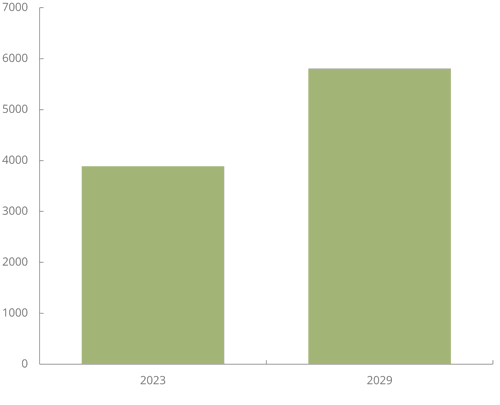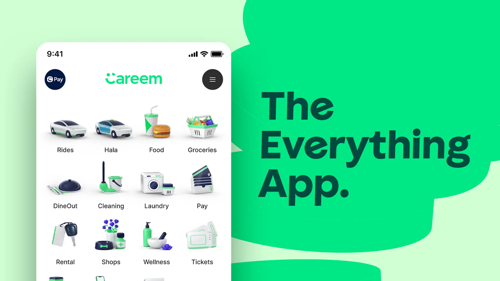Building a Successful Superapp: Lessons from Careem
Superapps have been a major point of discussion in the fintech space for several years, with many payment apps and digital wallets having ambitions to become one. The primary motivation for becoming a superapp is the expansion of revenue streams, which can increase an app’s profitability and diversify its sources of revenue, protecting the business from a downturn in any one area.
Given this advantage, it is easy to understand why a digital wallet would want to become a fully fledged super app. There is clearly growing potential for this, with our latest forecasts showing that the number of people using digital wallets will grow by 46% between 2024 and 2029.
Number of People Using Digital Wallets (m), 2024 and 2029

Source: Juniper Research
For businesses looking to adopt the superapp model, it is important to understand how other successful superapps have gained their position in their respective markets.
Let's look at Careem.
Careem was founded in 2012 in the UAE as a ride-hailing app. Since its launch, it has expanded its geographic coverage, and is now available in cities in Qatar, Saudi Arabia, Egypt, Morocco, Pakistan, Jordan, Iraq, Bahrain, and Kuwait. It has also expanded into groceries, deliveries, and payments. By 2024, Careem had more than 48 million customers across 80 cities in the 10 countries in which it operates.
Almost all superapps start off as specialised apps; in Careem’s case this was as a ride-hailing app. The advantage of starting off in this way is that it requires less development to get a working app ready to deploy compared with a more broadly focused one; allowing for lower costs and faster time to market. Another strength of this method is that it allows the app to target a specific gap in the market to build up a user base.

Source: Careem
It is important that, if a brand is launching a specialised app, with the intention of it becoming a superapp, the app is designed with modularity in mind. This will make it easier to integrate new features into the app as it grows. One effective way to go about this would be to build the app using a third-party platform. This is cheaper than hiring a development team to build it, and it allows the new app to benefit from the experience of the platform provider. It is crucial that a business selects the right platform for their app as, once one is selected, the vendor is limited by the platform’s capabilities. This means that selecting the wrong platform can prevent a vendor from expanding its capabilities into new areas as opportunities present themselves.
Once an app is established, the next step is to grow it. This is in terms of user base, geographic coverage, and range of services offered. In Careem’s case, it took the approach of focusing on expanding geographically. Between 2012 and 2017, it expanded to cover the 10 countries it covers today, but the only added features were ones which strengthened its ride-sharing business. This strategy grows the user base, building trust and familiarity with users. Due to this, as services expand, existing customers are more likely to adopt a new service from a provider with which they are already familiar.
A payment feature is a consistent part of most superapps. This allows the app to facilitate payments for its own services internally, as well as to tap into revenue from different types of money transfers. Careem first entered into the digital payment space with Careem Pay, a closed-loop P2P money transfer system. This was expanded into a full open-loop payment wallet in 2020, which allowed it to make payments and withdraw funds from the ecosystem. In 2023, Careem added remittances, starting off with the UAE-Pakistan corridor. This was to take advantage of the fact many of its drivers were Pakistani citizens who already transferred their income back to Pakistan. This was sufficiently successful that it has since expanded to include remittance corridors to the UK, India, and the Philippines.
This shows two important trends to making a successful superapp: understanding users and integrating suitable new services with existing ones. Careem understood that many its users were migrant workers who would be sending money to their home country. As these workers were earning money as drivers on the Careem app, this meant it already stored the money the user wished to transfer. This combined the ride-hailing element of the app with the remittance feature; creating an overall stronger offering. When adding new features, particularly payment ones, a brand must look at who its customer base is and what services it already offers. By offering services that synergise with existing offerings, and targeting existing customers, an app can maximise the chances of a new feature’s success. The downside to this is it focuses on an existing user base; potentially limiting its ability to grow the total customer base.

Source: infinum
Careem sets a clear example of how to grow a specialised app into a superapp, with others such as Grab and Gojek following similar paths. Vendors looking to launch an app or expand an existing one must understand what these success stories did to get to where they are, and draw relevant lessons for themselves. Key considerations are modularity from the beginning to simplify the process of expanding the wallet as it grows, targeting features to a specific audience or a gap in the market, and using inbuilt payments and funds to provide a seamless checkout experience and keep a user’s money within the superapp ecosystem.
Michael is a Senior Research Analyst at Juniper Research, and primarily conducts research on digital identity and payments markets. His recent reports include Digital Wallets, Digital Identity, and Instant Payments.
Latest research, whitepapers & press releases
-
 ReportDecember 2025
ReportDecember 2025AI Agents for Customer Experience Platforms Market: 2025-2030
Our comprehensive AI Agents for Customer Experience Platforms research suite comprises detailed assessment of a market that is set to disrupt mobile communications. It provides stakeholders with insight into the key opportunities within the AI agents for customer experience platforms market over the next two years.
VIEW -
 ReportDecember 2025Fintech & Payments
ReportDecember 2025Fintech & PaymentseCommerce Fraud Prevention Market: 2025-2030
Our eCommerce Fraud Prevention research suite provides a detailed and insightful analysis of this evolving market; enabling stakeholders from financial institutions, law enforcement agencies, regulatory bodies and technology vendors to understand future growth, key trends, and the competitive environment.
VIEW -
 ReportNovember 2025Telecoms & Connectivity
ReportNovember 2025Telecoms & ConnectivityeSIMs & iSIMs Market: 2025-2030
Juniper Research’s eSIMs and iSIMs research suite offers insightful analysis of a market set to experience significant growth in the next five years. The research suite provides mobile network operators (MNOs), original equipment manufacturers (OEMs), and eSIM management and platforms vendors with intelligence on how to capitalise on the market growth, and guidance on how eSIM-only devices and sensors, SGP.42, in-factory provisioning, and iSIMs will change the competitive landscape.
VIEW -
 ReportNovember 2025Fintech & Payments
ReportNovember 2025Fintech & PaymentsModern Card Issuing Platforms Market: 2025-2030
Our Modern Card Issuing Platforms Market research suite provides a detailed and insightful analysis of this evolving market; enabling stakeholders from banks, financial institutions, fintech companies, and technology vendors to understand future growth, key trends, and the competitive environment.
VIEW -
 ReportNovember 2025Fintech & Payments
ReportNovember 2025Fintech & PaymentsDigital Wallets Market: 2025-2030
Our digital wallets research suite provides detailed analysis of this rapidly changing market; allowing digital wallet providers to gain an understanding of key payment trends and challenges, potential growth opportunities, and the competitive environment.
VIEW -
 ReportOctober 2025Fintech & Payments
ReportOctober 2025Fintech & PaymentsDigital Identity Market: 2025-2030
Juniper Research’s Digital Identity research suite provides a comprehensive and insightful analysis of this market; enabling stakeholders, including digital identity platform providers, digital identity verification providers, government agencies, banks, and many others, to understand future growth, key trends, and the competitive environment.
VIEW
-
 WhitepaperDecember 2025Telecoms & Connectivity
WhitepaperDecember 2025Telecoms & ConnectivityHuman + AI: Drivers of Customer Experience AI Agents in 2026
Our complimentary whitepaper, Human + AI: Drivers of Customer Experience AI Agents in 2026, examines the key drivers of the AI agents for customer experience platforms market in 2025.
VIEW -
 WhitepaperDecember 2025Fintech & Payments
WhitepaperDecember 2025Fintech & PaymentsBeyond Chargebacks: The True Cost of Fraud for Digital Commerce
Our complimentary whitepaper, Beyond Chargebacks: The True Cost of Fraud for Digital Commerce, examines the state of the eCommerce fraud prevention market; considering the impact of evolving digital fraud strategies, including key trends such as identity theft, account takeovers, chargebacks, policy abuse and friendly fraud.
VIEW -
 WhitepaperNovember 2025Telecoms & Connectivity
WhitepaperNovember 2025Telecoms & ConnectivityeSIM-only Devices: The Impact on Operators, Consumers, and IoT
Our complimentary whitepaper, eSIM-only Devices: The Impact on Operators, Consumers, and IoT, explores the challenges and opportunities for the three segments, with a particular focus on eSIM-only smartphones and SGP.42.
VIEW -
 WhitepaperNovember 2025Fintech & Payments
WhitepaperNovember 2025Fintech & PaymentsUnlocking the Next Stage of Growth for Modern Card Issuing Platforms
This free whitepaper analyses key trends shaping the modern card issuing space, and the ways in which modern card issuing platforms can capture growth.
VIEW -
 WhitepaperNovember 2025Fintech & Payments
WhitepaperNovember 2025Fintech & PaymentsTop 10 Fintech & Payments Trends 2026
Fintech is evolving fast. From stablecoins to agentic AI, our annual guide reveals the shifts redefining payments, digital identity, and the future of money in 2026. Download your copy today.
VIEW -
 WhitepaperNovember 2025Fintech & Payments
WhitepaperNovember 2025Fintech & PaymentsDigital Wallets: Empowering Financial Inclusivity
Our complimentary whitepaper, Digital Wallets: Empowering Financial Inclusivity, examines the state of the digital wallets market; considering the impact of digital wallets on different geographies, how they are shaping the modern payments landscape through lower transaction fees and promoting financial inclusivity for underbanked populations, and how they are competing with established payment methods.
VIEW
-
Fintech & Payments
Digital Identity App Usage to Hit 6.2 Billion by 2030, Driven by Shift to Decentralised Models
December 2025 -
Telecoms & Connectivity
Travel eSIM Margins Under Pressure as Revenue per Gigabyte Falls 10% Globally in Two Years
December 2025 -
Telecoms & Connectivity
AI Agents to Power 1,000% More Customer Interactions for Enterprises Globally by 2027
December 2025 -
IoT & Emerging Technology
Global D2C Revenue Set for $370 Million Surge, But Satellite Operators Should Not Chase Full MNO Status
December 2025 -
Fintech & Payments
Digital Goods Fraud to Cost eCommerce Merchants $27 Billion Globally by 2030 as AI Tools Accelerate Attacks
December 2025 -
Fintech & Payments
AML Adoption to Hit 3.8 Million Businesses Globally by 2030, With Europe at the Forefront
November 2025





















